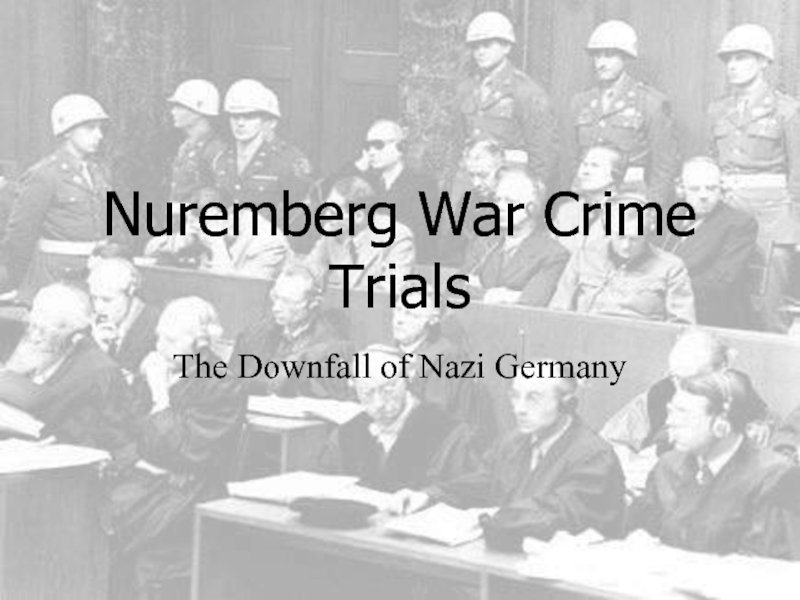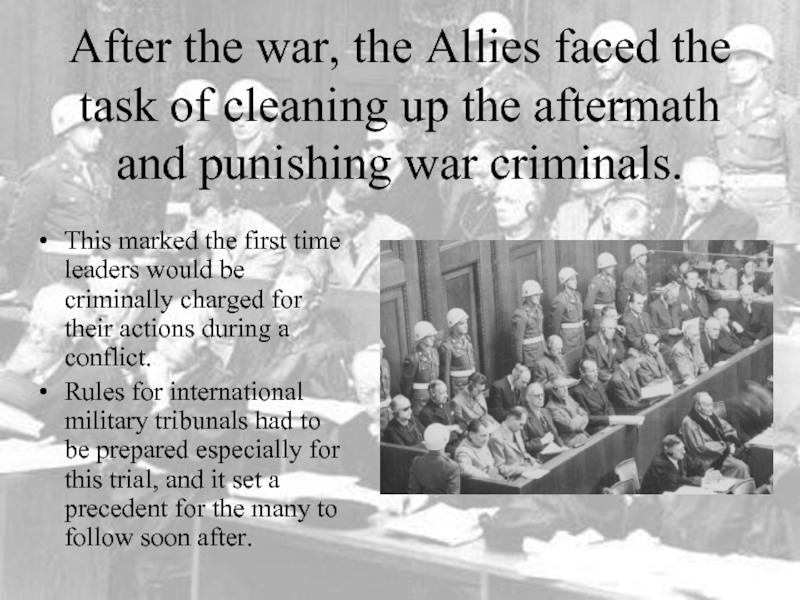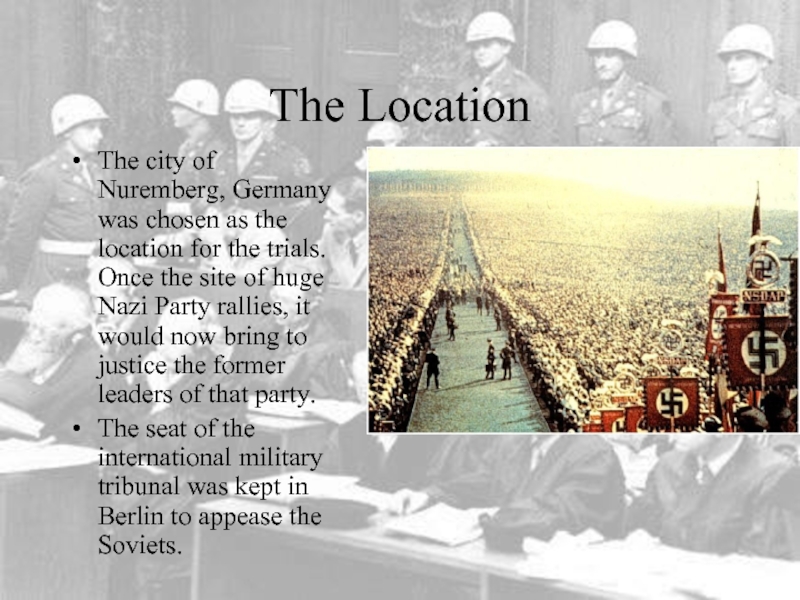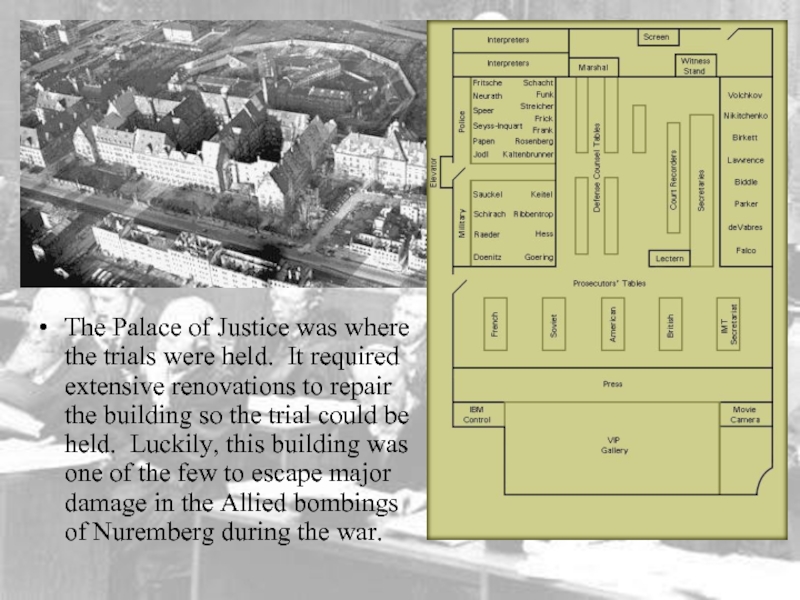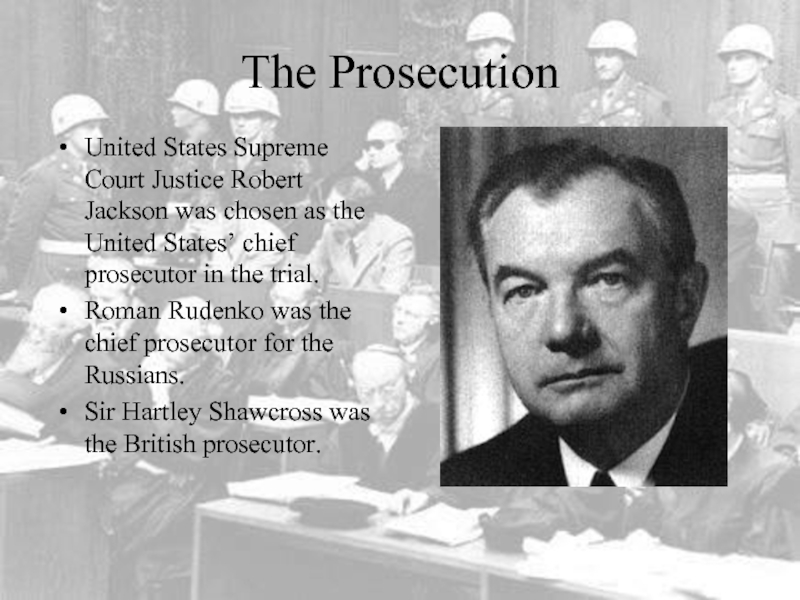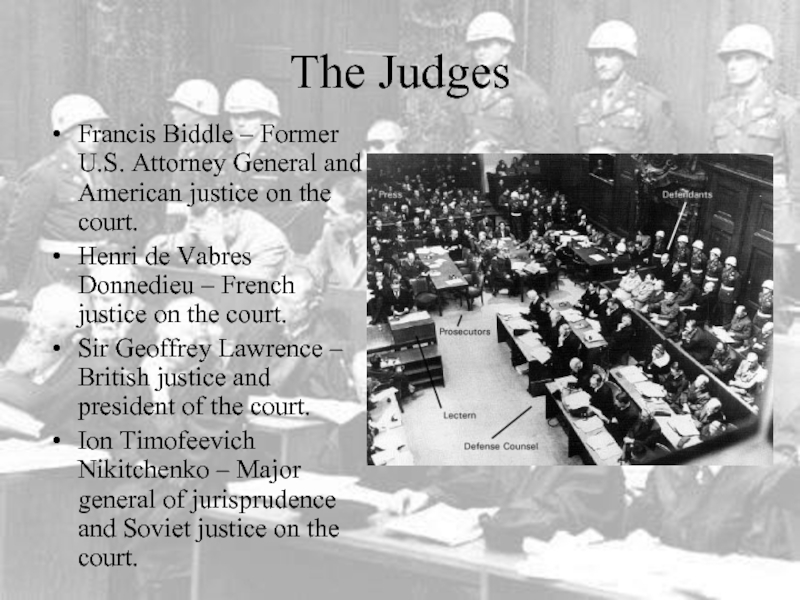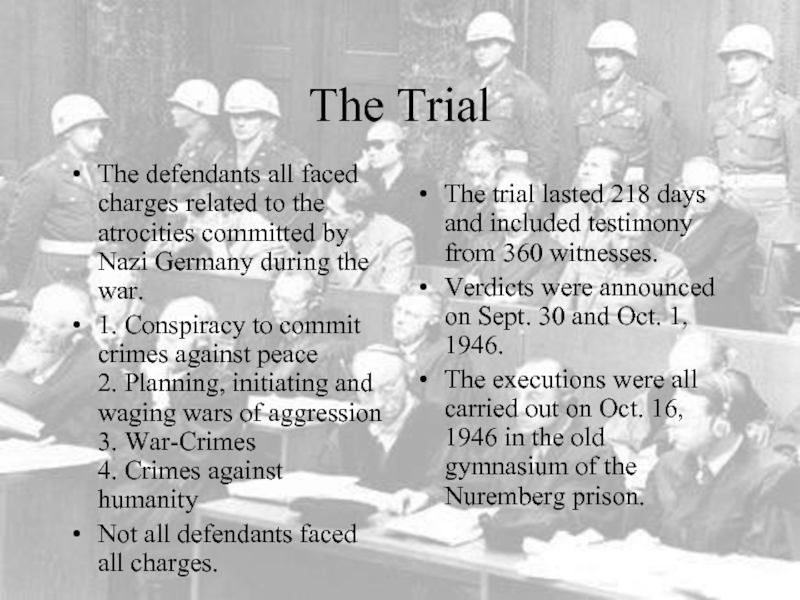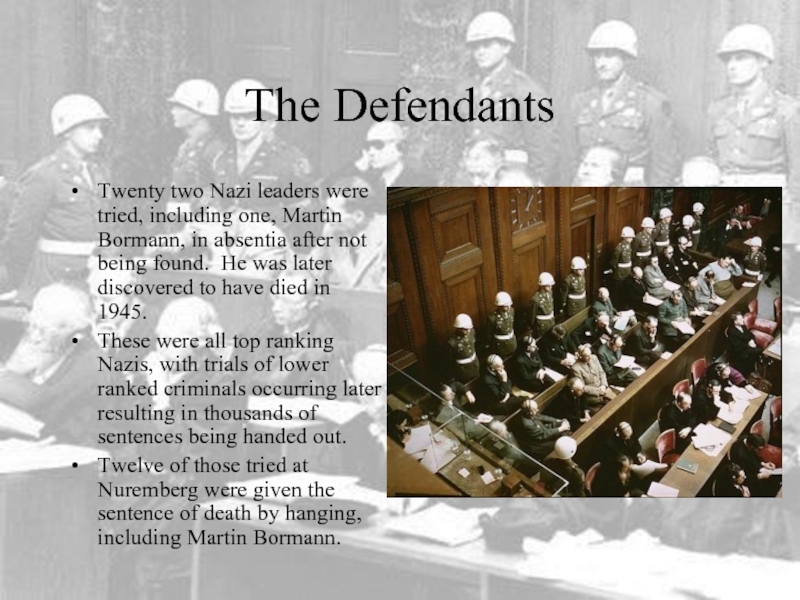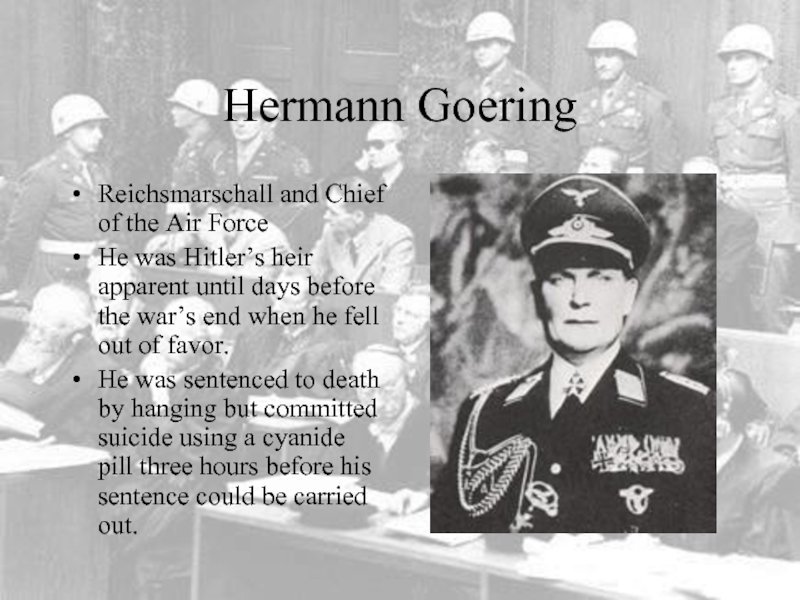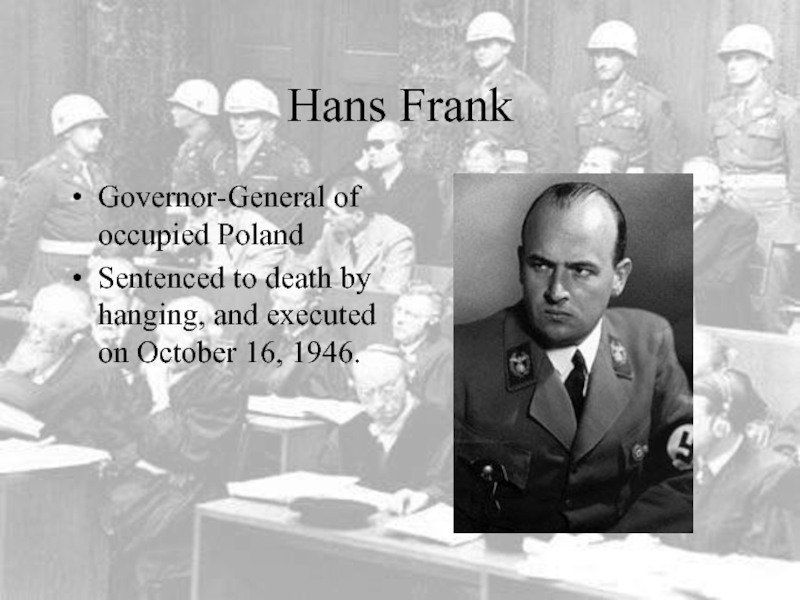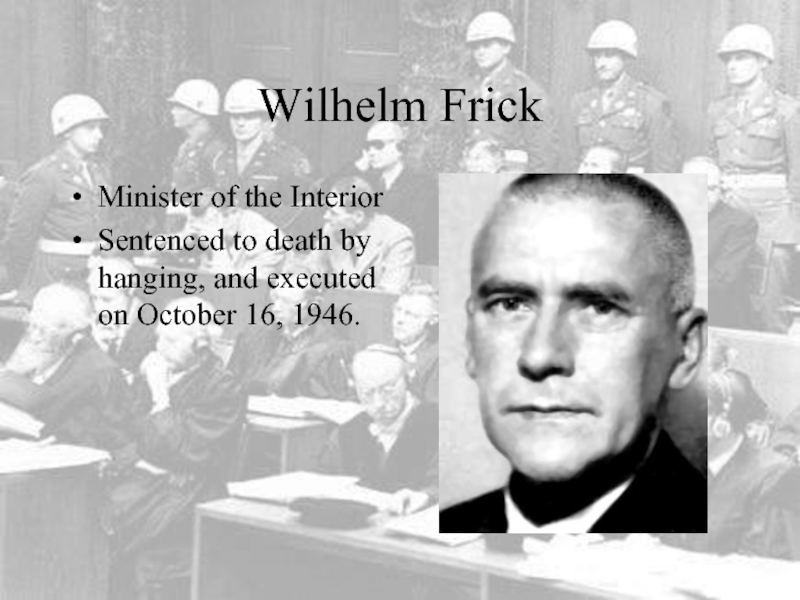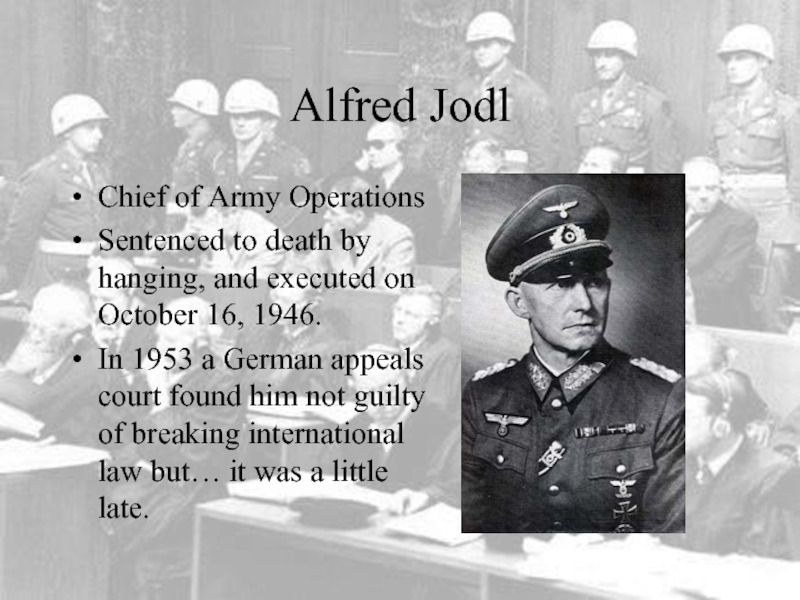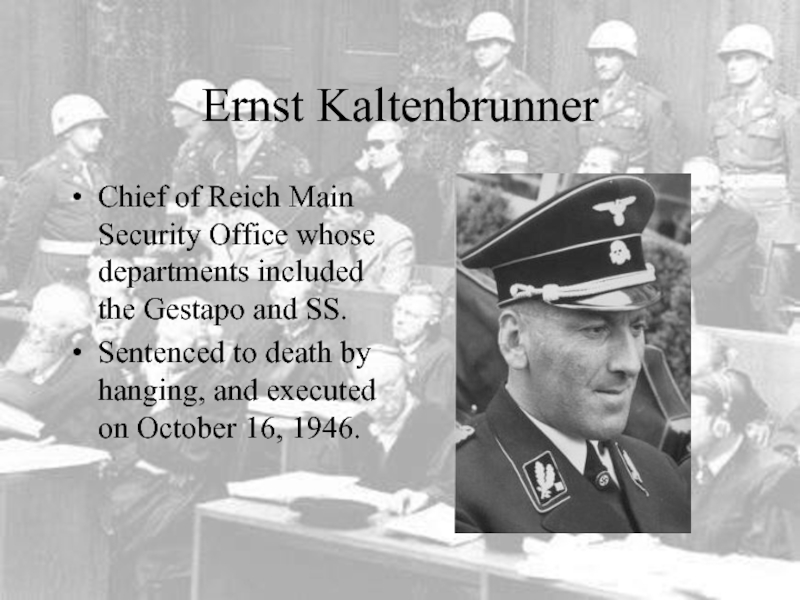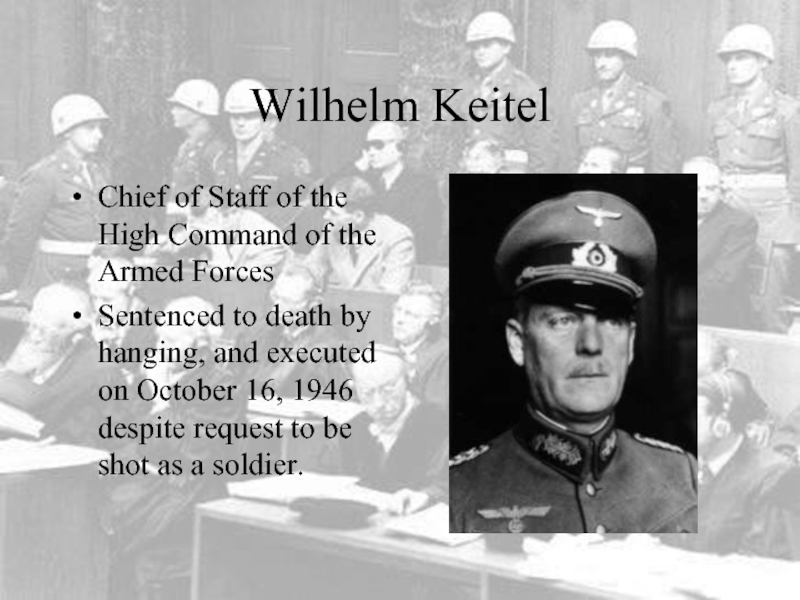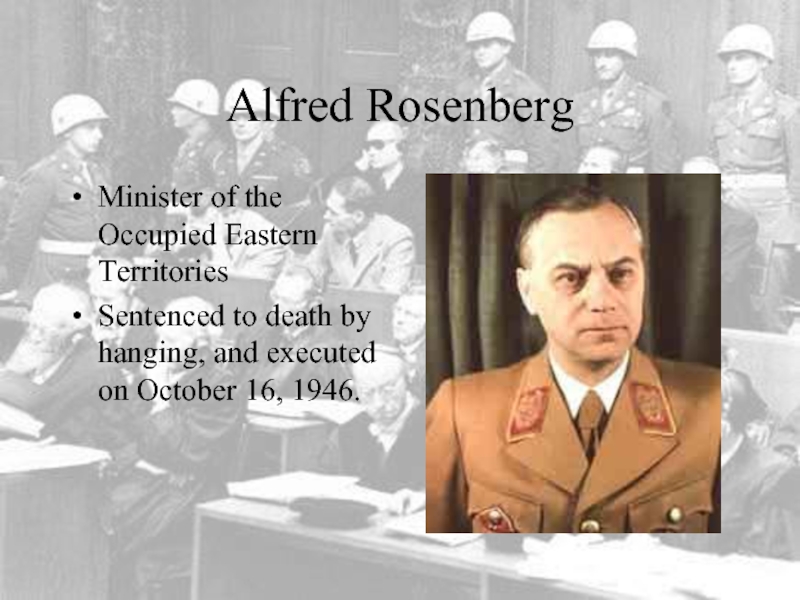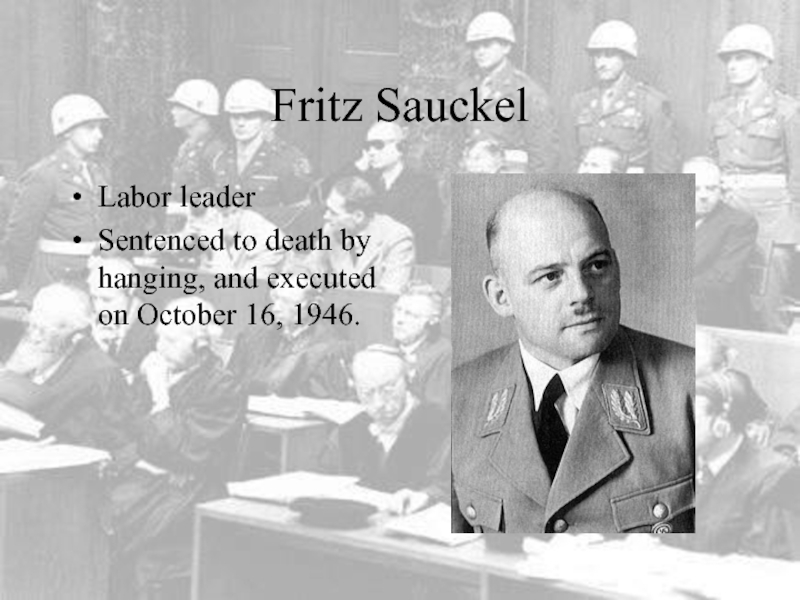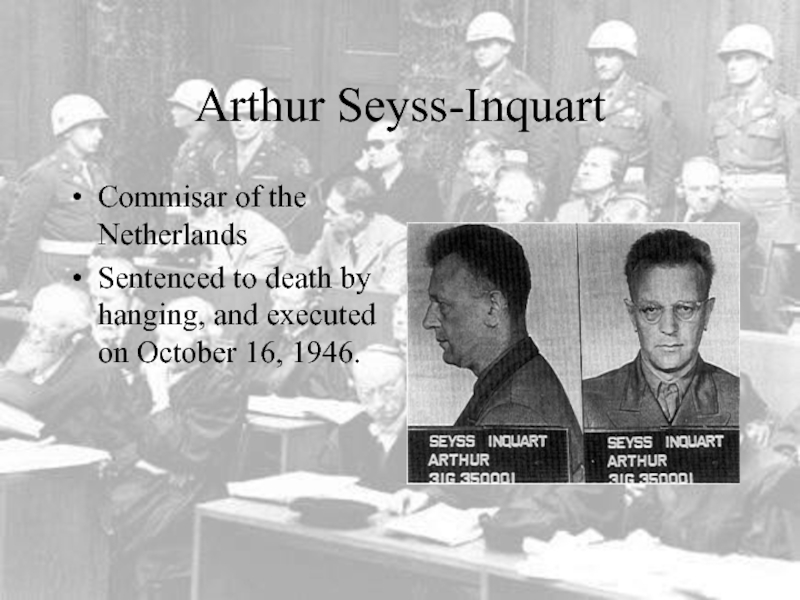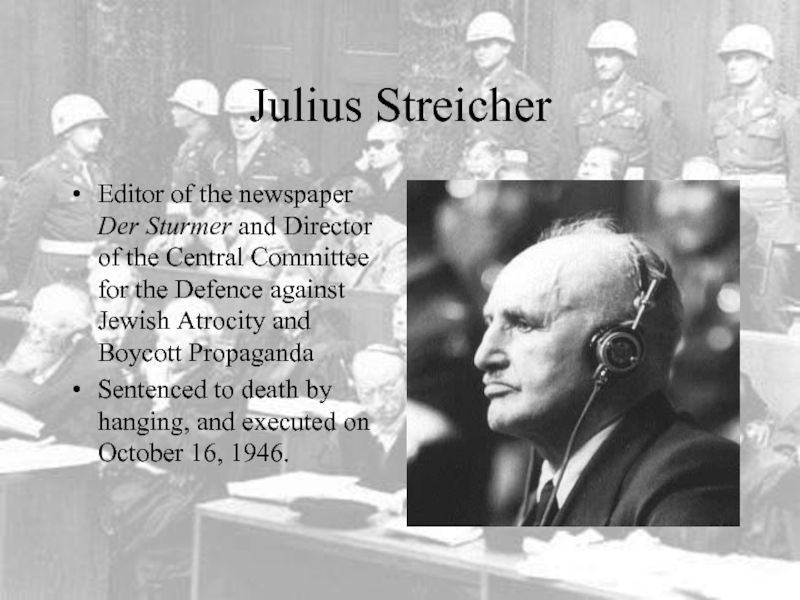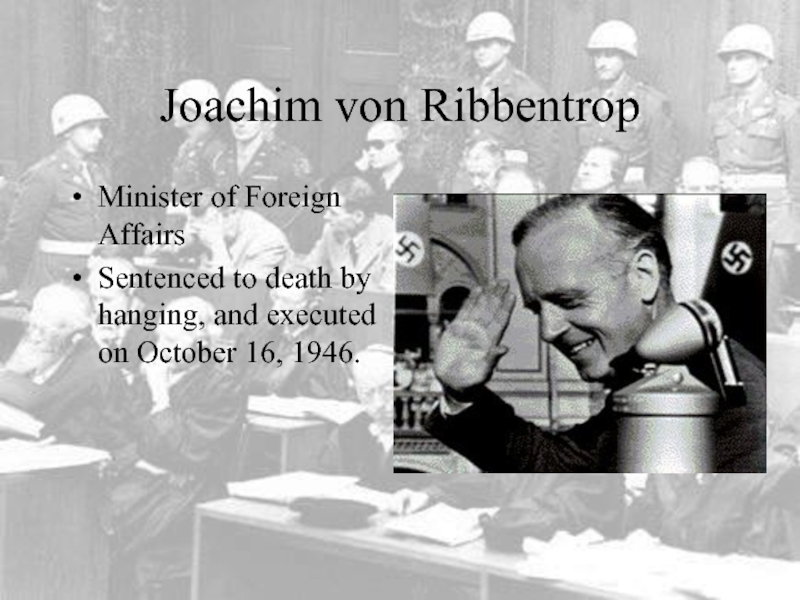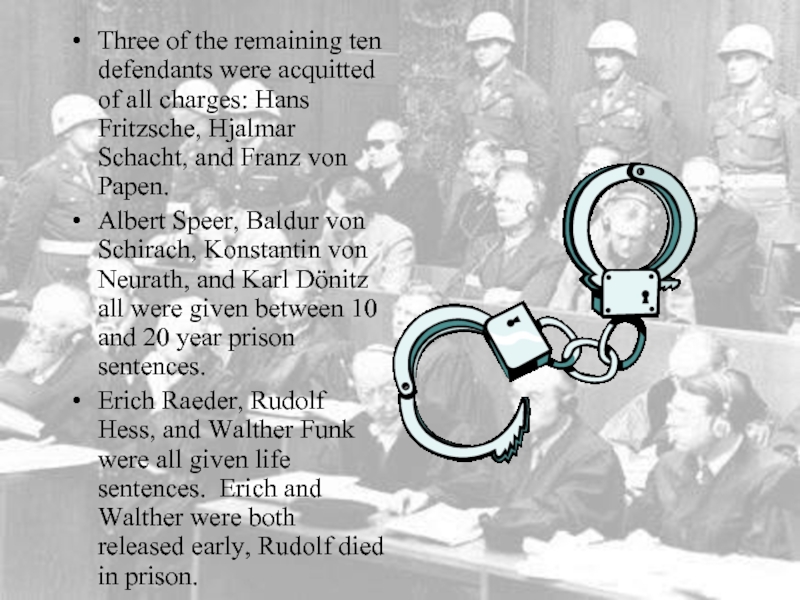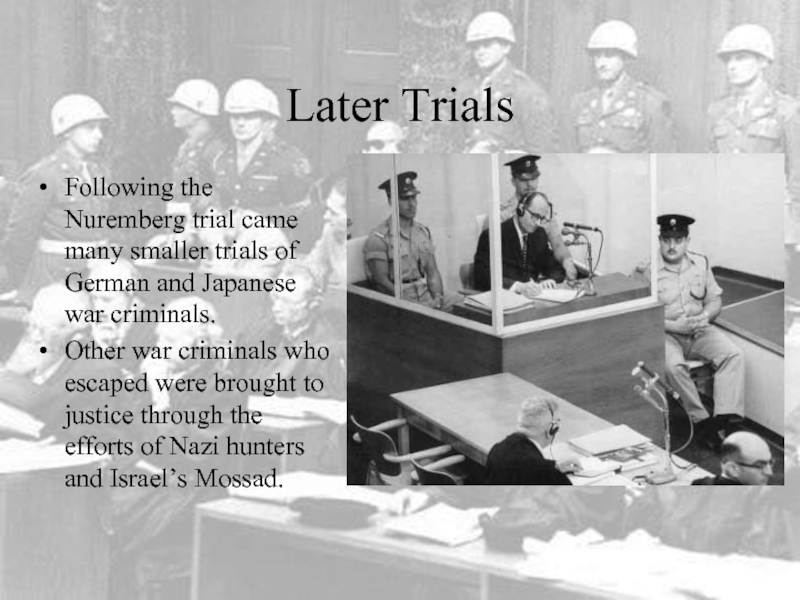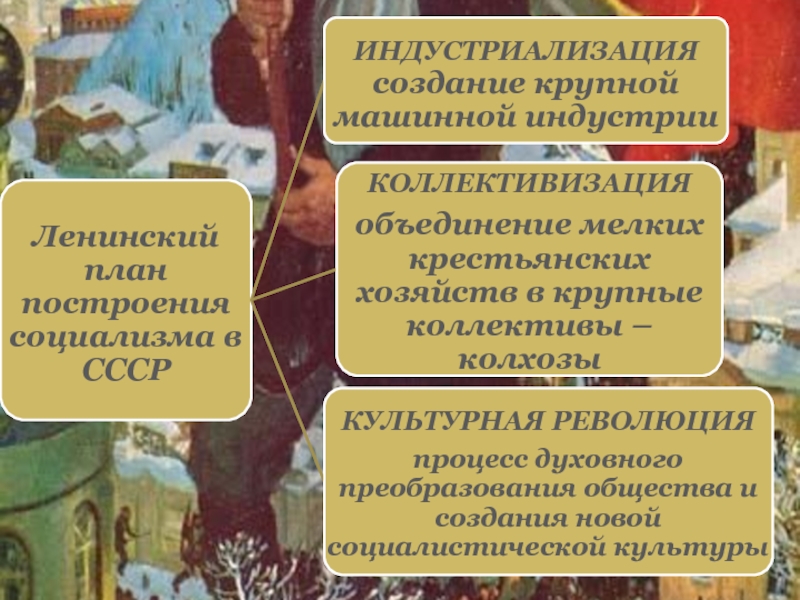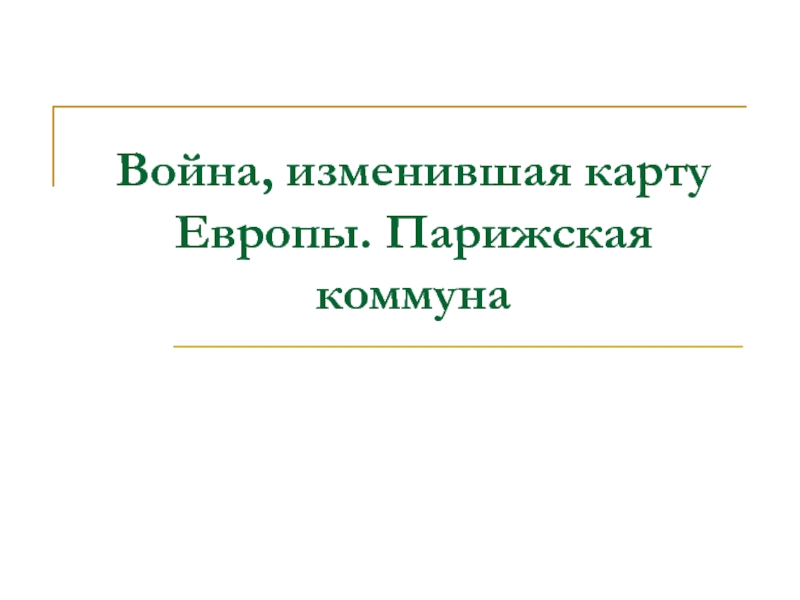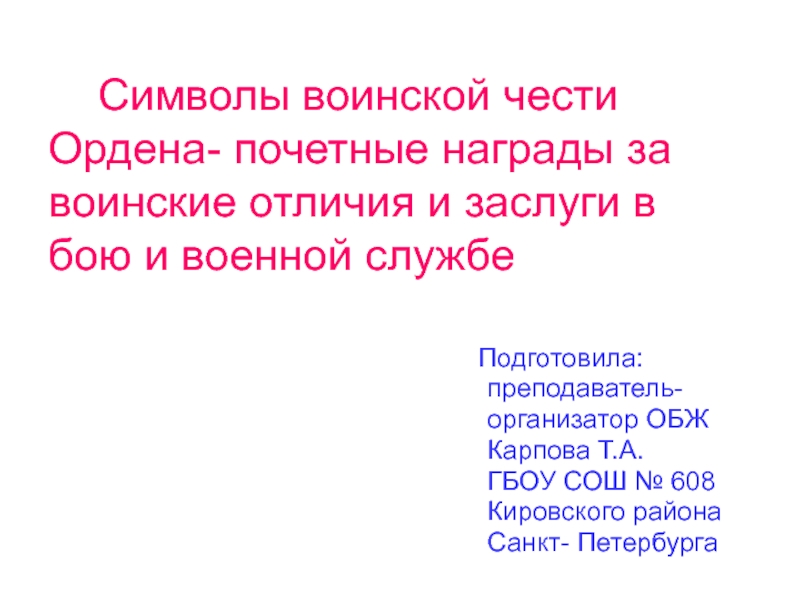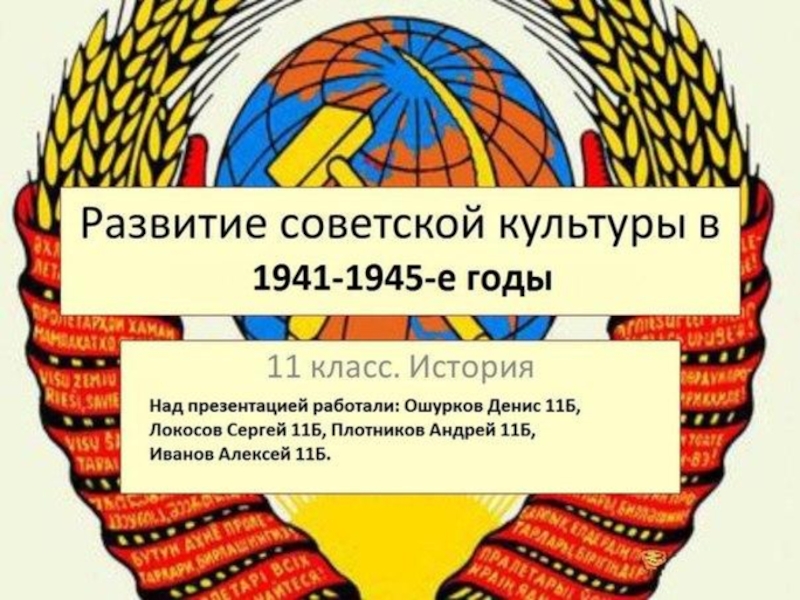- Главная
- Разное
- Дизайн
- Бизнес и предпринимательство
- Аналитика
- Образование
- Развлечения
- Красота и здоровье
- Финансы
- Государство
- Путешествия
- Спорт
- Недвижимость
- Армия
- Графика
- Культурология
- Еда и кулинария
- Лингвистика
- Английский язык
- Астрономия
- Алгебра
- Биология
- География
- Детские презентации
- Информатика
- История
- Литература
- Маркетинг
- Математика
- Медицина
- Менеджмент
- Музыка
- МХК
- Немецкий язык
- ОБЖ
- Обществознание
- Окружающий мир
- Педагогика
- Русский язык
- Технология
- Физика
- Философия
- Химия
- Шаблоны, картинки для презентаций
- Экология
- Экономика
- Юриспруденция
Nuremberg War Crime Trials презентация
Содержание
- 1. Nuremberg War Crime Trials
- 2. After the war, the Allies faced the
- 3. The Location The city of Nuremberg, Germany
- 4. The Palace of Justice was where the
- 5. The Prosecution United States Supreme Court Justice
- 6. The Judges Francis Biddle – Former U.S.
- 7. The Trial The defendants all faced charges
- 8. The Defendants Twenty two Nazi leaders were
- 9. Hermann Goering Reichsmarschall and Chief of the
- 10. Hans Frank Governor-General of occupied Poland Sentenced
- 11. Wilhelm Frick Minister of the Interior Sentenced
- 12. Alfred Jodl Chief of Army Operations Sentenced
- 13. Ernst Kaltenbrunner Chief of Reich Main Security
- 14. Wilhelm Keitel Chief of Staff of the
- 15. Alfred Rosenberg Minister of the Occupied Eastern
- 16. Fritz Sauckel Labor leader Sentenced to death by hanging, and executed on October 16, 1946.
- 17. Arthur Seyss-Inquart Commisar of the Netherlands Sentenced
- 18. Julius Streicher Editor of the newspaper Der
- 19. Joachim von Ribbentrop Minister of Foreign Affairs
- 20. Three of the remaining ten defendants were
- 21. Later Trials Following the Nuremberg trial came
Слайд 2After the war, the Allies faced the task of cleaning up
This marked the first time leaders would be criminally charged for their actions during a conflict.
Rules for international military tribunals had to be prepared especially for this trial, and it set a precedent for the many to follow soon after.
Слайд 3The Location
The city of Nuremberg, Germany was chosen as the location
The seat of the international military tribunal was kept in Berlin to appease the Soviets.
Слайд 4The Palace of Justice was where the trials were held. It
Слайд 5The Prosecution
United States Supreme Court Justice Robert Jackson was chosen as
Roman Rudenko was the chief prosecutor for the Russians.
Sir Hartley Shawcross was the British prosecutor.
Слайд 6The Judges
Francis Biddle – Former U.S. Attorney General and American justice
Henri de Vabres Donnedieu – French justice on the court.
Sir Geoffrey Lawrence – British justice and president of the court.
Ion Timofeevich Nikitchenko – Major general of jurisprudence and Soviet justice on the court.
Слайд 7The Trial
The defendants all faced charges related to the atrocities committed
1. Conspiracy to commit crimes against peace 2. Planning, initiating and waging wars of aggression 3. War-Crimes 4. Crimes against humanity
Not all defendants faced all charges.
The trial lasted 218 days and included testimony from 360 witnesses.
Verdicts were announced on Sept. 30 and Oct. 1, 1946.
The executions were all carried out on Oct. 16, 1946 in the old gymnasium of the Nuremberg prison.
Слайд 8The Defendants
Twenty two Nazi leaders were tried, including one, Martin Bormann,
These were all top ranking Nazis, with trials of lower ranked criminals occurring later resulting in thousands of sentences being handed out.
Twelve of those tried at Nuremberg were given the sentence of death by hanging, including Martin Bormann.
Слайд 9Hermann Goering
Reichsmarschall and Chief of the Air Force
He was Hitler’s heir
He was sentenced to death by hanging but committed suicide using a cyanide pill three hours before his sentence could be carried out.
Слайд 10Hans Frank
Governor-General of occupied Poland
Sentenced to death by hanging, and executed
Слайд 11Wilhelm Frick
Minister of the Interior
Sentenced to death by hanging, and executed
Слайд 12Alfred Jodl
Chief of Army Operations
Sentenced to death by hanging, and executed
In 1953 a German appeals court found him not guilty of breaking international law but… it was a little late.
Слайд 13Ernst Kaltenbrunner
Chief of Reich Main Security Office whose departments included the
Sentenced to death by hanging, and executed on October 16, 1946.
Слайд 14Wilhelm Keitel
Chief of Staff of the High Command of the Armed
Sentenced to death by hanging, and executed on October 16, 1946 despite request to be shot as a soldier.
Слайд 15Alfred Rosenberg
Minister of the Occupied Eastern Territories
Sentenced to death by hanging,
Слайд 17Arthur Seyss-Inquart
Commisar of the Netherlands
Sentenced to death by hanging, and executed
Слайд 18Julius Streicher
Editor of the newspaper Der Sturmer and Director of the
Sentenced to death by hanging, and executed on October 16, 1946.
Слайд 19Joachim von Ribbentrop
Minister of Foreign Affairs
Sentenced to death by hanging, and
Слайд 20Three of the remaining ten defendants were acquitted of all charges:
Albert Speer, Baldur von Schirach, Konstantin von Neurath, and Karl Dönitz all were given between 10 and 20 year prison sentences.
Erich Raeder, Rudolf Hess, and Walther Funk were all given life sentences. Erich and Walther were both released early, Rudolf died in prison.
Слайд 21Later Trials
Following the Nuremberg trial came many smaller trials of German
Other war criminals who escaped were brought to justice through the efforts of Nazi hunters and Israel’s Mossad.
